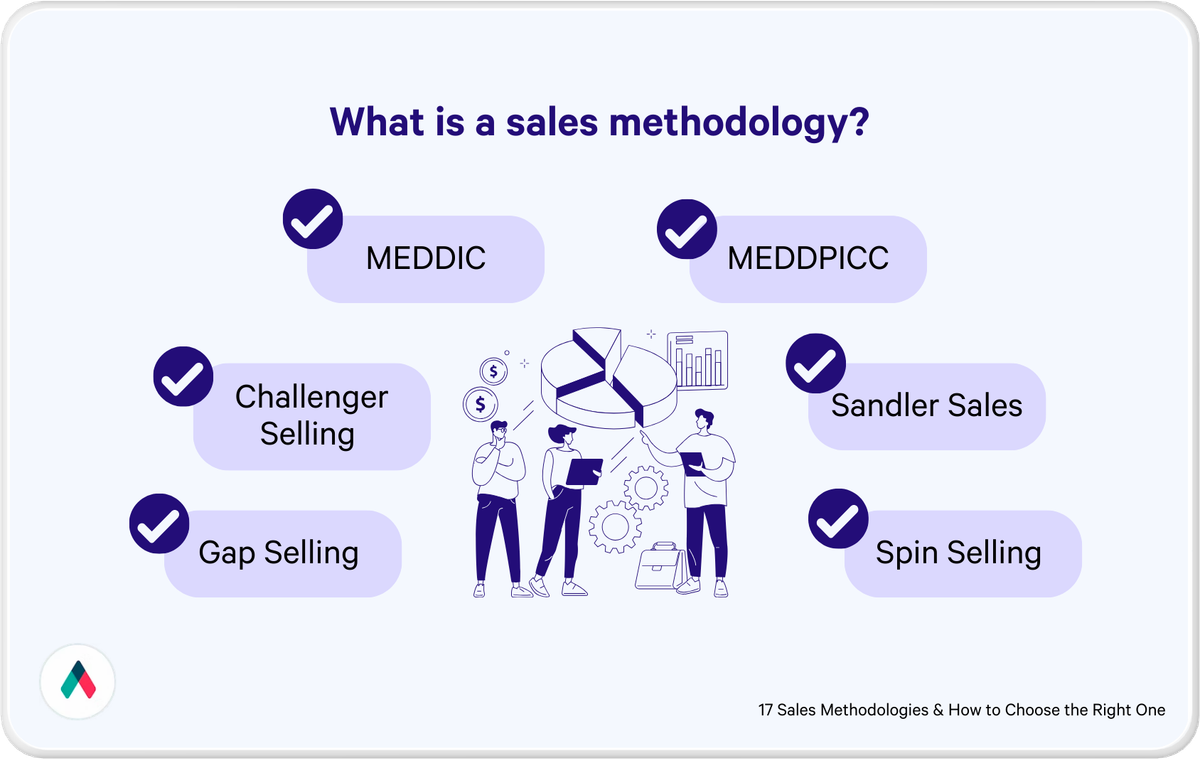What’s your sales methodology? If you can’t immediately answer that question, then you’re not alone. 48% of sales teams confess to having no defined sales methodology in place.
The other 52%, however, are already benefiting from an overarching methodological approach that guides and informs their strategy and tactics at every stage of the buying process. And consultative selling is one of the most effective approaches (identified by more than 53% of sales reps) used by sales organizations looking to strengthen trust, build relationships and enhance their understanding of their customer’s needs.
What is consultative selling?
Advising sales professionals to put the customer’s needs first is hardly groundbreaking, and at a cursory glance, the consultative sales approach could be dismissed as simply stating the obvious.
However, as with most sales methodologies, an effective consultative sales methodology is the result of effective implementation and execution. Reimagining every stage of your sales process and retraining your team in consultative sales skills will never be a ‘one-and-done.’
In a consultative selling environment, each sale will be executed using selling strategies that position the salesperson as a trusted advisor, using their expertise in the space to explore the customer’s situation and help them find their own answers about what they need.
Truly putting the customer first, and making each sales process a customer-specific consultation, requires both courage and curiosity at every level, from the sales rep to the C-suite. It means being prepared, if necessary, to tell a potential customer when you don’t have the best solution for their unique needs.
Consultative selling or product-based selling - what’s right for my business?
Not every offer requires you to build relationships that are deep and lasting. More traditional sales approaches like transactional and product-based selling methodologies can still put the customer first - but when your product is less complex, with a short sales cycle and a simpler or less flexible set of features, it’s probably unhelpful to dig too deep into your customer’s business.
There’s also no point exploring pain points for which you have no solution - from your perspective, it may feel like you’re deepening your relationship, but the customer may feel you’re wasting their time.
The maturity of the market is also a consideration, too. If you’re selling in a space where the potential issues and pain points faced by your customer are long-established and well-defined, it’s less likely you’re going to inspire any fresh perspectives.
In our recent Qwilr webinar, sales enablement expert Nathan Clark made this point in discussion with our founder, Mark Tanner:
“If it’s a highly defined problem set… and you’re thinking that you need to go in and stir up the pot, trying to bring ‘insight’ to some senior executive who probably knows the problem space better than you, it’s probably going to be a miss”.
Conversely, there are several market factors that would benefit teams using a consultative selling methodology. A long sales cycle, where relationships are managed over a greater period of time with more complex interactions and multiple stakeholders, would suit this approach.
Teams going to market with a new solution or a disruptive product would also find it useful to concentrate more on consultative processes, to help them gain a fuller understanding of how to position their product and its potential uses.
How to adopt a consultative selling approach
Unless your sales strategy is completely transactional, it’s very likely that your current approach already contains consultative elements and techniques - as we pointed out earlier, much of this methodology could be described simply as good sales practice. Even so, you’ll need to find a way to integrate the following consultative methodological tools into your process.
Active listening
Listening isn’t just for discovery calls. Engage at every stage of the buying process with what your prospect is saying - about their pain points, their specific needs, and the solution you’re offering - and your consultative sales process will inspire trust and social connection.
The active listening skillset requires a mindful practice of the following:
- Paying attention. “If you want to know how to make people shun you,” said Dale Carnegie, “talk incessantly about yourself. If you have an idea while the other person is talking, don't wait for him or her to finish: bust right in and interrupt in the middle of a sentence.”
This acerbic non-advice points out a social faux pas that everyone’s guilty of, from time to time - waiting for the other person to finish so that you can have your say. This bad habit has no place in your methodology or sales technique - whatever you eventually have to say will be automatically more relevant if you listen properly to what your prospect is saying.
It can even be a good idea to leave a slightly longer pause once they’ve finished speaking - this often leads the prospect to add additional clarification and insight they might not have shared otherwise. - Withholding judgment. You might have the perfect answer to your prospect’s problem. But until you can prove it, it’s not an answer - merely an opinion. If you feel there’s a conclusion that can be reached based on what you’re hearing, a consultative approach requires you to guide them to find it themselves. Avoid criticism and direct arguments when possible.
- Reflecting. An active listener will contribute in a way that reflects the speaker’s thoughts back to them. Using careful opening gambits (such as starting your reflection with ‘it seems like’), you can paraphrase their points back to them. This lets you summarize their points and check that you’ve understood them fully. It also helps build rapport by demonstrating that you’re listening properly and that their point of view is being heard.
Asking the right questions
Use questions as a strategic tool, and you can lead the sales conversation, as well as find out more about your prospect’s needs and pain points.
Rather than just relying on a constant stream of open-ended questions that could leave your prospect feeling talked out and irritable, look at using a questioning framework like the STAR interview method. This acronym stands for:
- Situation: questions designed to explore the general context surrounding your prospect and their needs.what result is your prospect looking to achieve?
- Task or Tension: what problem or problems is your prospect looking to solve?
- Action or Affect: what steps need to be taken to solve the problem?
- Result: what result is your prospect looking to achieve?
By building your questions around this framework, you’ll keep your prospect focused on what’s relevant while encouraging them to explore further through their answers.
You should also seek to use clarifying questions when possible, e.g., ‘can you explain that further?’ or ‘What do you mean by…’
In addition to avoiding potential misunderstandings, these allow for useful expansion on points that require further examination or that you might need the prospect to defend. If you disagree with something they’ve said, this is an excellent way to explore the point further while avoiding conflict.
Social selling and value-based content
You can front-load your consultative selling approach through a strong social media strategy and value-based content. If your online presence and interactions demonstrate your willingness to share your expertise, then your prospects will come to the discovery call, having already formed a positive impression of you. This is a real competitive advantage that creates the perfect foundation for sales success through a trust-based relationship, often referred too as social selling too.
Providing useful content such as detailed ‘how to’ guides, case studies, and industry reports also serves to build trust, as well as providing a subconscious sense of obligation using the reciprocity principle.
This psychological tenet taps into the very foundations of human society - before we had money, we exchanged favors, goods, and services. The idea of ‘I owe you one’ still exerts a strong pull, even if the initial gift is received digitally and anonymously.
Coaching
Another key point in our Sales Methodology webinar that Mark emphasized is the importance of ongoing sales training to the adoption of a new sales methodology.
“It’s not a one-and-done implementation. You need to be constantly having discussions, constantly coaching"
Mark Tanner, CEO of Qwilr
Putting peer learning systems in place to capture feedback and share best practices will also help. While each account will require a personalized approach, the team will still benefit from each other’s input as they build a bank of techniques and tools to support their consultative mindset.
Research
Consultative selling is customer-specific - each relationship is weighted and assessed according to its own merits.
In order to tailor your sales process to each individual buyer’s needs, it’s essential to gather as much background information as you can on target accounts, decision-makers, and stakeholders to help you formulate a good set of questions that demonstrate your trustworthiness and curiosity. Buyer intent data can play a valuable role in forming this profile of your prospect.
Pitfalls to avoid with a consultative selling approach
As we mentioned right at the start, nearly half of all sales teams don’t use a defined methodology. While some of these organizations don’t use a methodology because they’ve never tried or don’t want one, there’s also undoubtedly a number of teams who’ve tried - and failed.
So what can go wrong? Here are some of the hazards to watch for when implementing a consultative selling process and methodology.
No buy-in from sales leaders and frontline managers
One of the biggest reasons a methodological initiative can go awry is a lack of follow-up or ‘buy-in’ from that critical middle tier of sales management. In our webinar, Nathan Clark, reflecting on his time working at LinkedIn, explains:
“Trying to drive modern selling approaches… I knew very quickly which teams were going to win with this. And it was always the manager. If the frontline manager was on board, buying into the idea, and could fold the methodology into active practice, you were going to win. If the manager felt it was being pushed on them by the executive team, they’d say the right things out loud but quickly revert back to their old methodologies - and it was all over. I’d see that over and over.”
Misaligned processes
You’ve got to make room for consultative sellers to bring their curiosity and genuine interest to work. If you’re moving from a product-based or transactional model, it’s unlikely that all your existing processes will be as relevant or necessary to the new approach. Expert SaaS sales consultant Richard Harris bluntly describes the problem as a case of “too many fields in the CRM.”
“Use checkboxes and drop-down menus instead, or the process doesn’t work because you make it way too hard for people to do their job. Executives think they need it for their fancy report? Well, figure out a different way to get your fancy report and fix the CRM.”
Poor execution
Our increasingly virtualized world makes it easy to automate processes, scale up lead generation, and target decision-makers and specific accounts with personalized proposal templates and marketing materials.
The downside of all this labor-saving technology? Any mistakes in your execution are potentially going to be rolled out to hundreds of people simultaneously. Your sales collateral is a hugely valuable digital asset, but with low-quality execution, you run the risk of alienating or discouraging prospects.
Frequently asked questions
What are the benefits of consultative selling?
Consultative selling allows you to build stronger customer relationships with both new and existing customers by helping them explore their business needs and reach their own conclusions.
What are the differences between solution selling and consultative selling?
While both approaches are customer-centric and focus on ultimately solving the customer’s problems, a solution-selling approach attempts to diagnose and predict the customer’s problem while promoting the salesperson’s product as the clear solution. Consultative selling doesn’t make these assumptions - instead, sales professionals work alongside the customer to explore their issues, needs, and pain points.
Make the customer’s goals your own
Consultative selling doesn’t fit every market, and some teams may find internal and external obstacles blocking their path to adopting a consultative selling approach.
However, whatever your industry, business is ultimately about relationships. The basic principles of consultative selling resonate strongly with any sales team that believes in its own value proposition. We’ll leave the last words on the subject to Nathan Clark:
“Ultimately, if you believe you have an offer that is genuinely worth putting in the customer’s hands, then all of the steps you undertake should be in service of helping them achieve their goals. It’s easy to think of salespeople and buyers as antagonists, but it’s really about getting the buyer from round the other side of the table, and both looking towards a future where you’ve solved their problem.”
Consult with Qwilr
It’s important to use the right tools to match your methodology. With Qwilr’s business proposal templates, you can keep the focus on your customer’s needs and update your sales collateral to align with your sales conversation at every step of the process.
About the author

Dan Lever|Brand Consultant and Copywriter
Dan Lever is an experienced brand consultant and copywriter. He brings over 7 years experience in marketing and sales development, across a range of industries including B2B SaaS, third sector and higher education.


